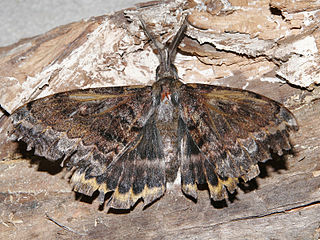
Moths are a paraphyletic group of insects that includes all members of the order Lepidoptera that are not butterflies, with moths making up the vast majority of the order. There are thought to be approximately 160,000 species of moth, many of which have yet to be described. Most species of moth are nocturnal, but there are also crepuscular and diurnal species.

The Pyraloidea are a moth superfamily containing about 16,000 described species worldwide, and probably at least as many more remain to be described. They are generally fairly small moths, and as such, they have been traditionally associated with the paraphyletic Microlepidoptera.

Anthelidae is a family of Australian lappet moths in the order Lepidoptera. It had earlier been considered to be part of the Lasiocampoidea superfamily, but a 2008 |molecular phylogenetic study, supported by a 2011 study, resulted in reincluding the Anthelidae in the superfamily Bombycoidea.

San Andreas is a 2015 American disaster film directed by Brad Peyton and written by Carlton Cuse, with Andre Fabrizio and Jeremy Passmore receiving story credit. The film stars Dwayne Johnson, Carla Gugino, Alexandra Daddario, Ioan Gruffudd, Archie Panjabi, and Paul Giamatti. Its plot centers on an earthquake caused by the San Andreas Fault devastating Los Angeles and the San Francisco Bay Area.
Elophila tenebralis is a moth in the family Crambidae. It was described by Oswald Bertram Lower in 1902. It is found in Australia, where it has been recorded from Queensland, Western Australia and Northern Territory.
Margarosticha sphenotis is a moth in the family Crambidae. It was described by Edward Meyrick in 1887. It is found in Australia, where it has been recorded from New South Wales, Queensland and the Northern Territory.
Theila triplaga is a moth in the family Crambidae. It was described by Oswald Bertram Lower in 1903. It is found in Australia, where it has been recorded from Queensland and Western Australia.
Hednota acontophora is a moth in the family Crambidae. It was described by Edward Meyrick in 1882. It is found in Australia, where it has been recorded from Victoria and South Australia.
Hednota argyroeles is a moth in the family Crambidae. It was described by Edward Meyrick in 1882. It is found in Australia, where it has been recorded from the Northern Territory and Queensland.
Neargyria argyraspis is a moth in the family Crambidae. It was described by Edward Meyrick in 1879. It is found in Australia, where it has been recorded from Queensland and New South Wales.
Hemiscopis violacea is a moth in the family Crambidae. It was described by Thomas Pennington Lucas in 1892. It is found in Australia, where it has been recorded from Queensland.
Trigonoorda trygoda is a moth in the family Crambidae. It was described by Edward Meyrick in 1897. It is found in Australia, where it has been recorded from Queensland, New South Wales and Western Australia.
Tetracona pictalis is a snout moth in the subfamily Spilomelinae of the family Crambidae. It was described by Warren in 1896. It is found in Australia, where it has been recorded in Queensland. The habitat consists of rainforests.
Conogethes tharsalea is a moth in the family Crambidae. It was described by Edward Meyrick in 1887. It is found in Australia, where it has been recorded from Queensland and the Northern Territory.
Eusabena paraphragma is a moth in the family Crambidae. It was described by Edward Meyrick in 1889. It is found on New Guinea and Australia, where it has been recorded from Queensland.

Glycythyma chrysorycta is a moth in the family Crambidae. It was described by Edward Meyrick in 1884. It is found in India, Sri Lanka, Myanmar, Japan, Korea, China, Taiwan and Australia, where it has been recorded from Queensland.
Herpetogramma platycapna is a moth in the subfamily Spilomelinae of the family Crambidae. It was described by Edward Meyrick in 1897. It is found in Malaysia, Indonesia (Sulawesi), New Guinea, the Keeling Islands and Australia, where it has been recorded from the Northern Territory.
Metallarcha eurychrysa is a moth in the family Crambidae. It was described by Edward Meyrick in 1884. It is found in Australia, where it has been recorded from South Australia, New South Wales and Western Australia.
Metallarcha leucodetis is a moth in the family Crambidae. It was described by Oswald Bertram Lower in 1899. It is found in Australia, where it has been recorded from New South Wales and South Australia.
Piletocera meekii is a moth in the family Crambidae. It was described by Thomas Pennington Lucas in 1894. It is found on the Indonesean island of Java and the Australian state of Queensland.




